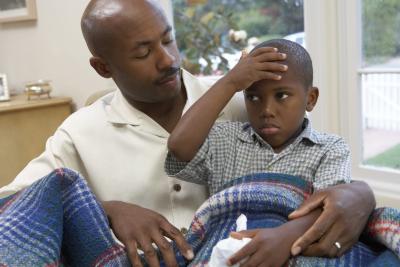Sinus congestion is a symptom of many different illnesses. Sinus congestion is common and is often accompanied by other symptoms, such as a headache and fever. The latter is usually a sign that the congestion has moved to an infection (sinusitis). Fevers and sinus congestion can also be a sign that the body is fighting a virus rather than something like allergies or a cold.
Location and Symptoms
There are four sets of sinuses. Two are located between and behind the eyes. The other two are located behind the cheeks and in the forehead, above the eyes. Depending on which sinuses are infected, there can be pain and swelling on just one side of the face. Nasal drip and stuffiness are also common symptoms. Some people get bad breath or a cough as a result of mucus dripping down the throat.
Function
The sinuses become congested when pollen (or another allergen) or a flu virus enters the passageways. This irritates the sinuses, which begin to produce copious amounts of mucus in an attempt to sweep out the microorganisms. The passageways become swollen, inflamed and full of mucus. If the invaders are a virus, the body may also produce a fever. The raised temperature of the body makes it easier for the immune system to fight off the virus. Fevers are also common in sinus infections.
Causes
Allergies (usually hay fever, or pollen allergies) and cold viruses are the leading causes of sinus congestion, according to the Lucile Packard Children’s Hospital at Stanford. In 5 percent of all cases of sinus congestion, bacteria is the culprit.
Prevention/Solution
It’s difficult to prevent the colds and allergies that lead to most sinus congestion. You can take steps to reduce the pressure, discomfort and “stuffed up” feeling, however. Keeping the nasal passageways moist will help reduce the inflammation, and keeping them clear will help you breathe easier. Try using a humidifier to loosen up the mucus, or take a long, steamy shower. A saline solution sprayed into the nostrils will also moisten and loosen up the sinus passages. Warm, wet compresses can soothe swollen eyes. Sleeping in an upright position will reduce the pressure in your sinuses, which may also reduce a headache.
Warning
Sinus congestion can lead to a sinus infection, which is sinusitis. This happens when bacteria begin to multiply in the sinus passageways, which are blocked by the mucus. As this happens, a fever develops and the area around the eyes and nose becomes red and inflamed. If your child develops a fever along with sinus congestion, take him to see a doctor. Antibiotics must be used to treat the infection, according to AboutKidsHealth.





